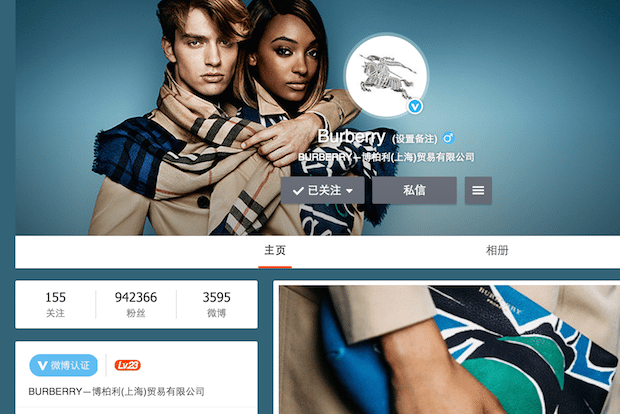
Burberry's Weibo account.
This article was published earlier in our weekly newsletter. Sign up through our “Newsletter Sign Up” box on the right.
After reports last year that users were abandoning microblogging platform Weibo in droves, the company’s latest earnings report indicates that it may be coming back from the dead. Although WeChat has cemented itself as China’s social media superstar du jour, brands shouldn't ignore the current and future potential of Weibo for digital marketing—while closely keeping track of the evolution of China’s social media ecosystem.
In the first quarter of 2015, Weibo had 198 million monthly active users, up 11.2 percent from the previous quarter and 38 percent year-on-year. In addition, the platform's daily active users grew by 34 percent over this period. These numbers mark a significant turnaround, given the fact that Weibo reported a loss of 28 million users in 2013 (as 37 percent of those who stopped using Weibo began using WeChat).
As WeChat siphoned users from Weibo, WeChat caught brands’ attention as the hottest social media platform to reach and influence the Chinese consumer. While WeChat has seen staggering growth, with a total of 549 million monthly active users in the first quarter of 2015, it’s clear that marketers can’t cut Weibo completely out of their social marketing strategy. Despite its myriad downsides, the platform offers branding opportunities that are quite different from those of WeChat. Where WeChat is more about 1:1 communication and personalized interaction with fans, Weibo is useful for reaching a mass audience with viral posts.
As a result, Weibo can often be seen as much more of a numbers game. But some brands are getting savvier about the way they approach their Weibo marketing, with a focus on both quality and quantity. When it comes to upping the viral factor of posts, many brands are being more careful about the key opinion leaders (KOLs) they employ rather than haphazardly choosing based on follower numbers alone. The personal branding of should not only align with a brand’s image, but their follower bases should be closely examined to make sure they’re as popular as they claim they are—they shouldn't be overrun by “zombie” or fake followers that were likely purchased.
Luxury brands also need to be on the lookout for changes underway with Weibo, which is partly owned by e-commerce giant Alibaba. As speculation has been happening for a long time now about what the connection means for the future of social commerce, Weibo announced that "certain planned initiatives with Alibaba are still expected to begin in the second quarter.” This comes at a time when Alibaba’s main competitor Tencent is continuing its partnership with Alibaba’s other main competitor JD.com, which sells directly through WeChat.
Whatever e-commerce initiatives are in store for Weibo, you can bet that they’re going to be heavily mobile-focused—86 percent of Weibo users go on the platform through their mobile devices, and mobile usage grew 57 percent year-on-year.